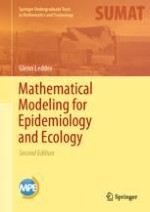2023 | OriginalPaper | Buchkapitel
4. Dynamics of Single Populations
verfasst von : Glenn Ledder
Erschienen in: Mathematical Modeling for Epidemiology and Ecology
Aktivieren Sie unsere intelligente Suche, um passende Fachinhalte oder Patente zu finden.
Wählen Sie Textabschnitte aus um mit Künstlicher Intelligenz passenden Patente zu finden. powered by
Markieren Sie Textabschnitte, um KI-gestützt weitere passende Inhalte zu finden. powered by
